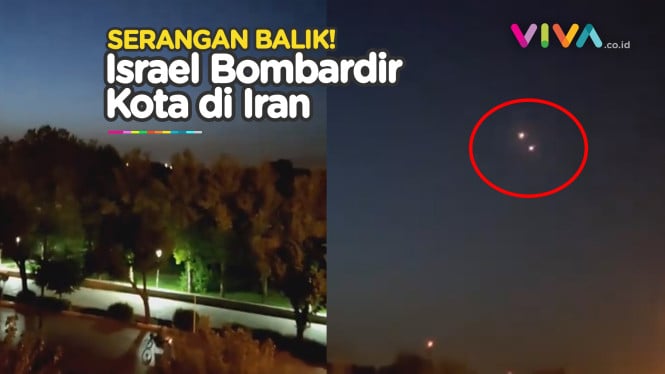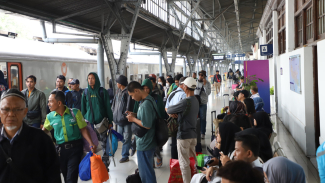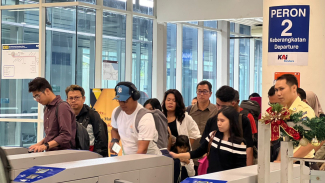VIVAnews- Archaeologists believe that the very first step of man-made transportation began either in Mesopotamia or Asia sometime around 4000-5000 BC with the invention of the wheel. It has been millennia since the first form of wheeled transportation was applied in Sumeria in around 3500 BC—taking the form of two-wheeled chariot. Humanity has since made leaps and bounds in transportation—from the wheel to the supersonic jet—changing the way we look at the world.
Each country in the world has its own unique types of transportation. Indonesia is no different. It is one of many places in the world having a wide variety of transportation. The following are some popular types transportation in Indonesia, some have been discontinued by the government, some are still operational, while others can be found only in remote areas.
Ojek Sepeda
In the past, ojek sepeda (bicycle taxis) were a common method of getting around Jakarta, Indonesian capital. People would utilize the services of ojek sepeda if they were in a hurry because this two-wheeled, foot-power-based transport tends to get through traffic faster than any other transports such as buses or taxis. Today, ojek sepeda are on the edge of extinction, perhaps partly because of the popularity and speed of ojek motor. It can only be seen in North Jakarta, around the Kota Station and Sunter. North Jakarta.
Becak
Becak (pedicabs) are either human-powered or motor-engine vehicle, equipped with one seat for carrying passengers in addition to the driver. The name of the environmentally friendly cart was derived from Hokkien 'be chia' which means horse-cart. Becak appeared in Indonesia in 1941. It initially gained popularity in Surabaya, East Java, before finally starting to operate in several areas throughout Indonesia. Human-powered becak are widely spread in Java, while motor-engine ones can be found in Sumatra. In 1980s, the Jakarta administration officially banned becak from operating in its area, reasoning that it was an exploitation over other humans.
Delman
In certain areas around Java and Bali, delman, a two- or four-wheeled buggy drawn by a horse, can still be found, although their numbers are decreasing. According to the free online encyclopedia Wikipedia, the carriage was named after Charles Theodore Deeleman, an engineer and lithographer who lived in Indonesia during the Dutch occupation period. Dutchmen called the buggy dos-á-dos (literally back-to-back in French language), a sort of horse-drawn carriage whose passenger seats were in back-to-back arrangement.
Ojek Motor
Those who live in hinterlands or metropolitan centers would probably be familiar with Ojek Motor (motorbike taxi). It is commonly referred to only as ojek since ojek sepeda (bicycle taxis) are hardly in existence in the main cities in Indonesia. Though their existence has not yet been legalized by the government, the two-wheeled, fuel-based transportation can be seen in almost every corner in Indonesia. People who are seeking for 'intimate', fast and cheap transport will certainly look for motorbike taxis. As with any regular taxi, motorbike taxis set their tariff based on distances. However, the tariff may vary due to certain circumstances such as the situation of the road (e.g. traffic, ruined pathways) or the quality of the motorbikes used (new motorbikes would cost higher than old ones).
Bajaj
Almost all Jakarta inhabitants are aware of Bajaj. This orange-colored, three-wheeled vehicle is widely-known for its sudden maneuver, which leads to a saying: “Only God knows when a Bajaj will turn left or right.” The name Bajaj is derived from Bajaj Auto, a major Indian automobile manufacturer and its India's largest two- and three-wheeler maker. Recently, the Indonesian government has launched a substitute for Bajaj because it is deemed to produce heavy pollutive emission. The substitute, Kancil, is considered to be more environmental friendly. However, despite the substitute vehicle, Bajaj can still be found pretty much anywhere in Jakarta.
Helicak
Due to its resemblance to a combination of helicopter and becak, the name helicak, short form of helicopter and becak, was thus used to describe this particular vehicle. Those who grew up in the 1970s could certainly see the three-wheeled public transportation in the streets of Jakarta. It commenced operation on March 24th, 1971. The main body and machine of the short-lived vehicle was Italy-made Lambretta scooter. Ali Sadikin, then Governor of Jakarta, initiated the helicak as a substitute public transportation for becak. Nonetheless, the inconsistent policy of Jakarta administration in supplying the vehicle caused the helicak to gradually disappear from the crowded roads of Jakarta.
Bemo
Bemo, short for 'becak motor' (motor-engine pedicab), started its operation in early 1962. It did not only operate in Jakarta, but also other Indonesian cities and towns, such as Bogor (West Java), Bandung (West Java), Surabaya (East Java), Malang (East Java), Padang (West Sumatra), and Denpasar (Bali). The three-wheeled vehicle was assembled in Japan and was only intended to transport consumer goods. Therefore, when it was converted into a public transportation, by installing two rows of passenger seats, facing each other, in the rear-end of the vehicle, there wasn't sufficient comfortable space for the passengers. As a result, passengers would bump their knees against one another. In 1971, the government started to wipe out bemo from the streets. Eventually, around 1996, a Jakarta gubernatorial instruction on bemo substitute-vehicle (APB) was issued. The policy was aimed at improving the prosperity of bemo drivers as well as providing people with better means of transportation. Today, bemo are still operating in several places like Manggarai, Bendungan Hilir, Gajah Mada, Mangga Besar (Central Jakarta), and Jakarta Kota Station (West Jakarta) among others.
Angkot
The term 'Angkot', is short for 'Angkutan Kota' (city transport), is commonly applied to any public means of transport which utilizes minivan to operate. This likely-customized public transport can be found almost everywhere in Indonesia. It can manage to take in around 10-14 passengers; surely, it depends on how the driver/owner modifies the car. Unlike city bus, angkot's fare is usually higher and the calculation is based on the distances covered. It is the regional government that has the authority to set the tariff. However, there are many angkot drivers who will ask for more money if a passenger is thought to give less; and such an act is absolutely subjective. The special well-known annoying characteristic of angkot is that it can pull over at any random spots either if a passenger wishes to get off or the driver sees a potential passenger on the roadside.
Metromini
“Road devils” is the term often attributed to the medium-sized 27-seat buses operating in Jakarta, although the number of seats in each bus may vary. Indeed, most Metromini drivers have devilish style of driving: zigzagging, speeding and, oftentimes, running into other vehicles. “Metromini” is actually a company providing public transportation in Jakarta. It serves various routes in Jakarta whereby every route is signaled by certain special code: S-coded buses operate in South Jakarta; P, Central Jakarta; T, East Jakarta; B, West Jakarta; U, North Jakarta.
TransJakarta
TransJakarta is a bus rapid transit system in Jakarta. TransJakarta started on January 15th, 2004 and currently has 7 lanes with 32 new lanes (or “corridors”) under construction. TransJakarta was designed to provide the citizens of Jakarta with a fast public transportation system design to help reduce rush hour traffic. The capacity of each bus is 30 seated passengers and 55 standing, although during rush hours these numbers are often exceeded up to 80 standing passengers. The passengers of TransJakarta buses come from different backgrounds, including expatriate executives, company and public employees, peddlers, and housewives and their children. Transjakarta's ticket prices are subsidized by the central government. The system is modeled on the successful TransMilenio system in Bogota, Columbia, thus why the lanes are called “corridors.” The TransJakarta is often called “busway.”
Electric Trains (KRL)
The electric trains (KRL – Kereta Rel Listrik) are mainly found in Jakarta and its surrounding areas and they dominantly serve commuters working in the metropolitan center. The Jabodetabek (short for Jakarta, Bogor, Depok, Tangerang, Bekasi) KRL have been operating since 1976 and provide economic and business classes. The trains halt at such main stations as Tanah Abang, Jatinegara and Manggarai. During the Dutch Indies period, the electric trains were utilized to link Batavia and Jatinegara (or, at the time, Meester Cornelis) in 1925. In those days, the railway trains were manufactured by Werkspoor and Heemaf Hengelo. In the 1960s, electric trains were no longer used because of their inappropriate condition. In 1976, the Indonesian Railway Company (PJKA) imported some trains from Japan. Today, the KRL is notorious for its less-human aspect. It is common to see people pack the train-roof because of the limited capacity of the coaches that far exceeds the demand for it.


















